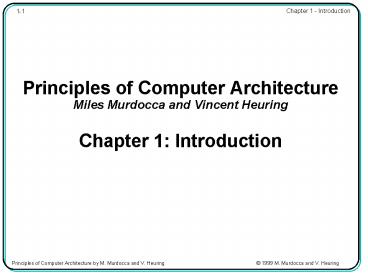Principles of Computer Architecture Miles Murdocca and Vincent Heuring Chapter 1: Introduction - PowerPoint PPT Presentation
1 / 22
Title:
Principles of Computer Architecture Miles Murdocca and Vincent Heuring Chapter 1: Introduction
Description:
Principles of Computer Architecture by M. Murdocca and V. Heuring 1999 M. ... Some Definitions ... There is a concept of levels in computer architecture. ... – PowerPoint PPT presentation
Number of Views:59
Avg rating:3.0/5.0
Title: Principles of Computer Architecture Miles Murdocca and Vincent Heuring Chapter 1: Introduction
1
Principles of Computer ArchitectureMiles
Murdocca and Vincent HeuringChapter 1
Introduction
2
Chapter Contents
- 1.1 Overview
- 1.2 A Brief History
- 1.3 The Von Neumann Model
- 1.4 The System Bus Model
- 1.5 Levels of Machines
- 1.6 Upward Compatibility
- 1.7 The Levels
- 1.8 A Typical Computer System
- 1.9 Organization of the Book
- 1.10 Case Study What Happened to Supercomputers
3
Some Definitions
- Computer architecture deals with the functional
behavior of a computer system as viewed by a
programmer (like the size of a data type 32
bits to an integer).
4
Some Definitions
- Computer architecture deals with the functional
behavior of a computer system as viewed by a
programmer (like the size of a data type 32
bits to an integer). - Computer organization deals with structural
relationships that are not visible to the
programmer (like clock frequency or the size of
the physical memory).
5
Some Definitions
- Computer architecture deals with the functional
behavior of a computer system as viewed by a
programmer (like the size of a data type 32
bits to an integer). - Computer organization deals with structural
relationships that are not visible to the
programmer (like clock frequency or the size of
the physical memory). - There is a concept of levels in computer
architecture. The basic idea is that there are
many levels at which a computer can be
considered, from the highest level, where the
user is running programs, to the lowest level,
consisting of transistors and wires.
6
Pascals Calculating Machine
- Performs basic arithmetic operations (early to
mid 1600s). Does not have what may be considered
the basic parts of a computer. - In the early 1800s, Babbage put the concepts
of mechanical control and mechanical calculation
together into a machine that has the basic parts
of a digital computer.
(Source IBM Archives photograph.)
7
The von Neumann Model
- The von Neumann model consists of five major
components
8
The von Neumann Model
- The von Neumann model consists of five major
components(1) input unit
Input Unit
Input Unit
9
The von Neumann Model
- The von Neumann model consists of five major
components(1) input unit (2) output unit
Input Unit
Output Unit
Input Unit
10
The von Neumann Model
- The von Neumann model consists of five major
components(1) input unit (2) output unit (3)
arithmetic logic unit
Arithmetic/Logic Unit (ALU)
Input Unit
Output Unit
Input Unit
11
The von Neumann Model
- The von Neumann model consists of five major
components(1) input unit (2) output unit (3)
arithmetic logic unit (4) memory unit
Memory Unit
Arithmetic/Logic Unit (ALU)
Input Unit
Output Unit
Input Unit
12
The von Neumann Model
- The von Neumann model consists of five major
components(1) input unit (2) output unit (3)
arithmetic logic unit (4) memory unit (5)
control unit.
Memory Unit
Arithmetic/Logic Unit (ALU)
Input Unit
Output Unit
Input Unit
Control Unit
13
The von Neumann Model
- The von Neumann model consists of five major
components(1) input unit (2) output unit (3)
arithmetic logic unit (4) memory unit (5)
control unit.
Memory Unit
Arithmetic/Logic Unit (ALU)
Input Unit
Output Unit
Input Unit
Control Unit
14
The System Bus Model
- A refinement of the von Neumann model, the
system bus model has a CPU (ALU and control),
memory, and an input/output unit. - Communication among components is handled by a
shared pathway called the system bus, which is
made up of the data bus, the address bus, and the
control bus. There is also a power bus, and some
architectures may also have a separate I/O bus.
15
Levels of Machines
There are a number of levels in a computer
(the exact number is open to debate), from the
user level down to the transistor level.
Progressing from the top level downward, the
levels become less abstract as more of the
internal structure of the computer becomes
visible.
16
Views of the Machine
- The Programmers View The Instruction Set
Architecture (ISA)
17
Views of the Machine
- The Programmers View The Instruction Set
Architecture (ISA) - The Computer Architects View Includes all
levels of the machine
18
A Typical Computer System
19
The Motherboard
The five von Neumann components are visible in
this example motherboard, in the context of the
system bus model.
Source TYAN Computer, www.tyan.com
20
Manchester University Mark I
Supercomputers, which are produced in low
volume and have a high price, have been largely
displaced by, high-volume low-priced machines
that offer a better price-to-performance ratio.
(Source http//www.paralogos.com/DeadSuper)
21
Moores Law
Computing power doubles every 18 months for the
same price.
22
Moores Law
Computing power doubles every 18 months for the
same price. Project planning needs to take this
observation seriously an architectural
innovation that is being developed for a
projected benefit that quadruples performance in
three years may no longer be relevant the
architectures that exist by then may already
offer quadrupled performance and may look
entirely different from what the innovation needs
to be effective.































